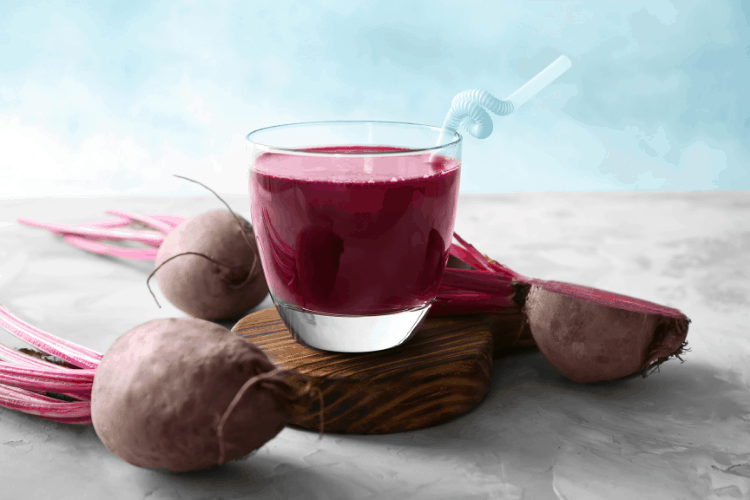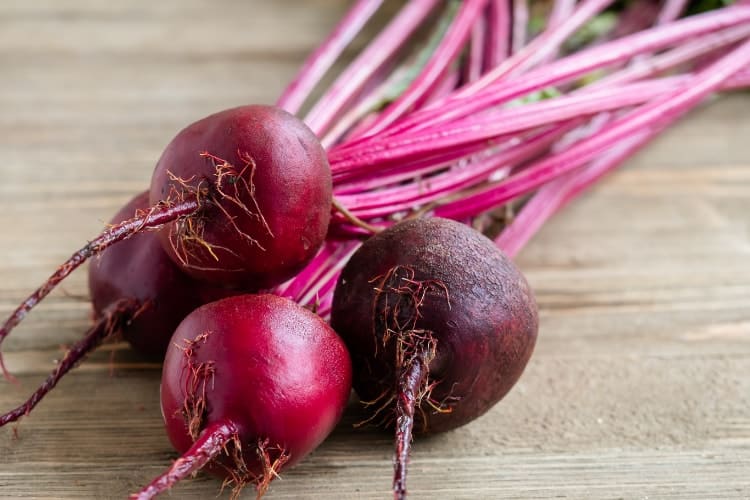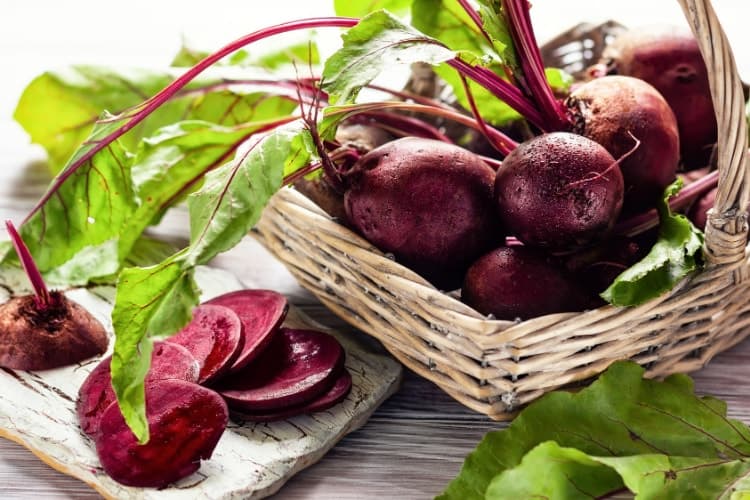
Whether you’re struggling with fatigue, unusual food cravings, pale skin or some other signs of iron deficiency anemia, you just might benefit from drinking a beet smoothie for low iron.
Both the beetroot and its mild-tasting leaves contain iron, as well as other nutrients that support iron absorption.
So, if you’re looking for new ways to add more iron into your diet, then keep reading because this post is going to give you:
- Details on how beets support iron balance.
- An overview of how much iron to expect from a beetroot and beet greens.
- A beet smoothie recipe that uses every part of the plant.
IS BEETROOT GOOD FOR LOW IRON?

Beetroot is a natural source of iron, as well as other nutrients that play a role in iron absorption. This includes nutrients like vitamin A, vitamin C and fiber. In addition, beets are known to support the liver, an organ that plays a key role in balancing iron levels.
Now, to get a better understanding of why beets are good for low iron, let’s take a closer look at how the nutrients in beets support healthy iron levels.
Beets Contain Vitamin A Which Helps Iron Deficiency
- Some research indicates that vitamin A deficiency contributes to the development of anemia. In fact, epidemiological surveys show that there’s a high prevalence of anemia in populations that also have low vitamin A (source).
- Not surprisingly, vitamin A deficiency has a negative effect on iron metabolism i.e. the various processes in the body that are necessary for balancing iron levels.
- A double-blind study was done with children, 54% of whom were anemic and 77% of whom had low vitamin A. The children were given vitamin A supplements and after 10 months, the mean hemoglobin increased by 7 g/dL. In addition, the percentage of children who were anemic went from 54% down to 38%.
- Lastly, the same study also showed that vitamin A stimulates the production of erythropoietin, a hormone that is essential for the production of red blood cells. This matters for anyone with low iron because more red blood cells means more hemoglobin (an iron-rich protein that transports oxygen throughout the body).
Vitamin C In Beetroot Improves Iron Absorption
- Vitamin C is known to enhance the absorption of iron. This is particularly helpful for non-heme (plant) iron which the body doesn’t absorb quite as easily as heme (meat) iron.
- The source of vitamin C doesn’t seem to impact its ability to enhance iron absorption. This means your vitamin C could come from a supplement or a vitamin-C rich juice. As long as the vitamin C and iron are consumed at the same time, you reap the benefits (source).
Beetroot’s Fiber Content May Help Iron Absorption
- Beets are a natural source of fiber which some experts say helps with iron absorption (source).
- Another study concluded that except for bran fiber, other fibers have a neutral effect on iron levels (source).
- So, best case, fiber might help you absorb more iron. Or worst case, it won’t do anything (unless it’s bran) 🙂
Beets Could Improve Iron Balance by Supporting Liver Health
- One scientific paper reveals that the liver is the CEO (or in their words, the “conductor”) when it comes to balancing iron levels. This is because the liver makes a hormone called hepcidin which tightly regulates iron levels so that they don’t get too high or too low.
- Many nutrients in beets – such as iron, calcium, B-vitamins and different antioxidants – all support liver health (source).
- Beets also contain betaine, a compound that protects the liver from certain toxins and supports liver function (source).
ARE BEETS RICH IN IRON?

100 grams of raw and cooked beetroot contains approximately 0.8mg of iron, which is 4.4% of the recommended iron intake for a non-pregnant adult female. On the other hand,100 grams of beet greens contain 2.57mg of iron, which is approximately 14.3% of the recommended iron intake (1, 2, 3). So, overall, beet greens are a much richer source of iron than the actual beetroot.
That said, please don’t take this to mean that you should skip the beetroot and only consume the greens.
As with all things related to food, variety and balance is key.
So, play around with making smoothies that contain just one part of the beets or both. This will keep you from getting bored with the same smoothie every single day.
By the way, if you’re curious about the other nutrients in beetroot, here’s a summary (source):
| Nutrient | Amount (per 100g) |
|---|---|
| Potassium | 325mg |
| Phosphorus | 40mg |
| Magnesium | 23mg |
| Protein | 1.61g |
| Folate | 109µg |
| Vitamin C | 4.9mg |
| Calcium | 16mg |
| Fiber | 2.8g |
By the way, for more info on some other essential benefits of beets, be sure to check out this article I put together on beets and hormone balance.
In addition, this quick video from Dr. Berg provides a nice overview of some more cool good stuff that comes from beets!
IRON-RICH BEET SMOOTHIE RECIPE
This beet smoothie recipe combines beetroot and beet greens with vitamin C-rich blueberries.
In addition, dates are added for natural sweetness and because they’ve also been shown to be effective at improving iron deficiency (you can get all the details in this article on eating dates for iron deficiency).
Ingredients (makes 1 serving)
1 fresh banana (ripe)
½ cup unsweetened almond milk
¾ cup red beets (peeled and diced)
2 pitted dates
1 cup beet greens (chopped, de-stemmed and tightly packed)
1 ½ cups frozen blueberries
Instructions
- Add all ingredients into a blender in the order listed. Blend on high until smooth. Pour into a glass (or bowl) and enjoy.
NOTES:
- you can replace the beet greens with spinach.
- blueberries can be replaced with raspberries. Since raspberries are less sweet, the smoothie will have a stronger beet flavor.
- this smoothie has a medium consistency, which means you can drink it or eat it as a smoothie bowl. Adjust the quantity of almond milk depending on how you like your smoothies.
- add any smoothie toppings of your choice such as more fresh fruit, nuts, dates, shredded coconut and so on.
ADDITIONAL TIPS AND COMMON QUESTIONS ABOUT BEETS SMOOTHIE FOR LOW IRON
Do you have to cook beets before blending?
While it’s not required, you can certainly cook beets before adding them to a smoothie. The main benefit here is that they will be softer and easier to blend.
However, if you simply make sure to chop up raw beets before adding them to a blender, that will make the blending process easy too.
Do keep in mind that cooking changes the flavor of beets. So, you can experiment with cooked and raw to see which flavor you prefer.
What happens if you eat too many beets?
One of the most common side effects of eating beets is red/pink urine or stool. This is known as beeturia and it’s caused by betanin, which is the compound that gives beets their distinctive red color (source).
Some people have a hard time breaking down betanin and this results in red pee or stool.
Interestingly, beeturia is sometimes a sign of low iron and studies show that beeturia occurs in 66 to 80% of people with iron deficiency anemia. So, if you have low iron, don’t be surprised if you experience beeturia. It’s generally considered harmless.
However, it’s always a good idea to check with your doctor to make sure that there are no other health issues contributing to the changes in color.
Who should avoid beetroot?
Beets can lower blood pressure so, if you’re on blood pressure medication, check with your doctor before adding beets to your diet.
There’s also some concern that excessive amounts of beets may worsen kidney disease. Therefore, If you have a history of kidney stones or other kidney issues, you should consider checking with your doctor before moving forward with beets.

CONCLUSION
Increasing one’s iron levels isn’t simply about taking iron supplements or eating iron-rich foods. It’s also about ensuring that the body has the nutrients it needs to absorb that iron. And beets are just one of the foods that can provide you with those essential nutrients.
Plus, with beets you have the option of using the root, the leaves or both when making an iron-boosting smoothie.
I hope this article gave you more clarity on how beets can be used to boost iron and your overall health.
Related Posts:
Healthy Smoothies for Low Iron (For Energy, Weight Loss, Natural Glow)

